Albanian Orthodox Church
| Autocephalous Orthodox Church of Albania Kisha Ortodokse Autoqefale e Shqipërisë | |
|---|---|
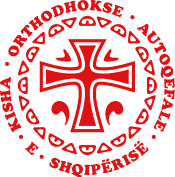 Seal | |
| Founder |
Apostle Paul Theofan Stilian Noli[1] |
| Independence | 17 September 1922[2] |
| Recognition | Autocephaly recognised in 1937 by the Ecumenical Patriarchate of Constantinople. |
| Primate | Archbishop Anastasios of Albania |
| Headquarters | Resurrection Cathedral, Tirana, Albania |
| Territory | Albania and Albanian diaspora |
| Possessions | — |
| Language |
Albanian (Greek,[3] Macedonian and other languages can be used for all those who are used to have their liturgy in other languages, with the condition that the liturgy text is approved by OACA) |
| Members | 500,000[4]-700,000-800,000[5] (claimed), number much higher when diaspora is considered. |
| Bishops | 6 |
| Priests | 135 |
| Parishes | 909 |
| Monasteries | 150 |
| Website | http://www.orthodoxalbania.org/ |
The Autocephalous Orthodox Church of Albania (Albanian: Kisha Ortodokse Autoqefale e Shqipërisë) is one of the newest autocephalous Eastern Orthodox Churches. It declared its autocephaly in 1922 through its Congress of 1922, and gained recognition from the Patriarch of Constantinople in 1937.
The church suffered during the Second World War, and in the communist period that followed, especially after 1967 when Albania was declared an atheist state, and no public or private expression of religion was allowed.
The church has, however, seen a revival since religious freedom was restored in 1991, with more than 250 churches rebuilt or restored, and more than 100 clergy being ordained. It has 909 parishes spread all around Albania, and around 500,000 to 550,000 (unconfirmed) faithful.[4] The number is claimed to be as high as 700,000 by some Orthodox sources – and higher when considering the Albanian diaspora.[6][7]
History
Ecclesiastically, Christians in Albania being part of the Illyricum province were under the jurisdiction of the Bishop of Rome (1st-8th century).[8] At 732-733 AD the ecclesiastical jurisdiction of Illiricum was transferred to the Ecumenical Patriarchate of Constantinople.[9][8] The schism of 1054 formalized the split of Christianity into two branches, Catholicism and Orthodoxy that was reflected in Albania with the emergence of a Catholic north and Orthodox south.[8] During the moment of schism (1054) Albanians were attached to the Eastern Orthodox Church and were all Orthodox Christians.[8][10][11]
Orthodox Church during the Ottoman Period
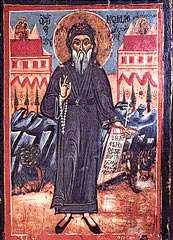
The official recognition of the Eastern Orthodox Church by the Porte resulted in the Orthodox population being tolerated until the late 18th century.[12][13][14] The Orthodox population of Albania was integrated into the Patriarchate of Constantinople, with the population of central and south-eastern Albania being under the ecclesiastical jurisdiction of the Orthodox Archbishopric of Ohrid, and the population of south-western Albania being under the ecclesiastical jurisdiction of the Metropolis of Ioannina.[15][16]
During the late eighteenth century, the poverty of the Orthodox Church, the illiterate clergy, a lack of clergy in some areas and liturgy in a language other than Albanian,[12][17][18][19] the reliance of the bishoprics of Durrës and southern Albania upon the declining Archbishopric of Ohrid, due in part to simony, weakened the faith among the Church's adherents and reduced the ability of the Orthodox Albanians in resisting conversion to Islam.[17][18]
By mid-19th century, because of the Tanzimat reforms started in 1839, which imposed mandatory military service on non-Muslims, the Orthodox Church lost adherents as the majority of Albanians had become Muslim.
Movement for establishing an authocephalous Albanian Orthodox Church

In the 19th century, Orthodox Albanians under the Patriarchate of Constantinople had liturgy and schooling in Greek and toward the late Ottoman period mainly identified with Greek national aspirations.[24][25][26][27][28] For Orthodox Albanians, Albanianism was closely associated with Hellenism, linked through the faith of Orthodoxy and only during the Eastern crisis and thereafter was that premise rejected by a few Orthodox Albanianists.[29] In southern Albania during the late Ottoman period being Albanian was increasingly associated with Islam, while from the 1880s the emerging Albanian National Movement was viewed as an obstacle to Hellenism within the region.[30][31] Some Orthodox Albanians mainly from Korçë and its regions began to affiliate with the Albanian National movement by working together with Muslim Albanians regarding shared social, geopolitical Albanian interests and aims causing concerns for Greece.[31][32][33][34] Contribution to the national movement by Orthodox Albanian nationalists was mainly undertaken outside the Ottoman state in the Albanian diaspora with activities focusing on educational issues and propaganda.[35] As Orthodoxy was associated with Greek identity, the rise of the Albanian national movement caused confusion for Orthodox Albanians as it interrupted the formation of a Greek national consciousness.[27]
_of_Korytsa_and_Premeti_(1902-1906).jpg)
At the onset of the twentieth century the idea to create an Albanian Orthodoxy or an Albanian expression of Orthodoxy emerged in the diaspora at a time when the Orthodox were increasingly being assimilated by the Patriarchate and Greece through the sphere of politics.[29] The Orthodox Albanian community had individuals such as Jani Vreto, Spiro Dine and Fan Noli involved in the national movement and some of them advocated for an Albanian Orthodoxy in order to curtail the Hellenisation process occurring amongst Orthodox Albanians.[38][39] In 1905, priest Kristo Negovani who had attained Albanian national sentiments abroad returned to his native village of Negovan and introduced the Albanian language for the first time in Orthodox liturgy.[22][21][23] For his efforts Negovani was murdered by a Greek guerilla band on orders from Bishop Karavangelis of Kastoria that aroused a nationalist response with the Albanian guerilla band of Bajo Topulli killing the Metropolitan of Korçë, Photios.[20][21][22][23] In 1907, an Orthodox Albanian immigrant Kristaq Dishnica was refused funeral services in the United States by a local Orthodox Greek priest for being an Albanian nationalist involved in patriotic activities.[40] Known as the Hudson incident, it galvanised the emigre Orthodox Albanian community to form the Albanian Orthodox Church under Fan Noli who hoped to diminish Greek influence in the church and counter Greek irredentism.[40][41][42][38] On March 18, 1908, as a result of the Hudson Incident Fan Noli was ordained as a priest by Russian bishop Platon in the United States.[43][44][45][46] Noli conducted the Orthodox liturgy (March 1908) for the first time among the Albanian-American community in the Albanian language. Noli also devoted his efforts toward translating the liturgy into Albanian and emerging as a leader of the Orthodox Albanian community in the USA visited in 1911 the Orthodox Albanian diasporas in Romania, Ukraine and Bulgaria.[43] For Albanian nationalists, Greek nationalism was a concern toward the end of the 19th century due to overlapping territorial claims toward the ethnically mixed vilayet of Yannina.[47][48] Those issues also generated a reaction against Greek nationalists that drove the Albanian desire to stress a separate cultural identity.[47][49]
Autocephaly and statutes
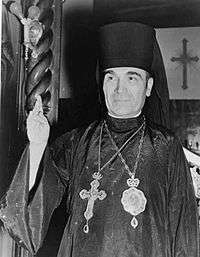
After Albanian independence in 1912, Noli (who in 1924 would also be a political figure and prime minister of Albania), traveled to Albania where he played an important role in establishing the Orthodox Albanian Church.[43] On September 17, 1922, the first Orthodox Congress convened at Berat formally laid the foundations of an Albanian Orthodox Church and declared its autocephaly.[40][50][51][2] Fan Noli was consecrated as Bishop of Korçë and primate of all Albania while the establishment of the Church was seen as an important development for maintaining Albanian national unity.[40][50][51] At the end of the congress the First Statute of the Church was approved.
The Church had a Second Statute that amended the First Statute in a second congress gathered in Korçë on June 29, 1929.[52] Also on September 6, 1929, the first Regulation of General Administration of the Church was approved.[53] The Patriarchate in Istanbul recognised the independence or autocephaly of the Orthodox Albanian Church in 1937.[40]
On November 26, 1950, the Parliament of Albania approved the Third Statute that abrogated the 1929 Statute. Such new statute required Albanian citizenship for the primate of the church in its article 4. With the exception of the amendments made in 1993, this statute is still in force for the Church.[54]
On January 21, 1993, the 1950 statute was amended and 1996 it was approved by the President of the Republic Sali Berisha. In particular article 4 of the 1950 statute that required Albanian citizenship for primate of the church was no longer required.
On November 3 and 4, 2006, at the new Monastery of St. Vlash in Durrës, there was a special Clergy-Laity Assembly of the Orthodox Autocephalous Church of Albania, attended by 257 representatives (including all clergy members). At this Assembly the New Constitution (Statute) of the Church was analyzed and accept unanimously. On November 6, 2006, the Holy Synod approved this Constitution (Statute). On November 24, 2008, the Orthodox Autocephalous Church of Albania and the Council of Ministers signed an agreement according to the 1998 Albanian Constitution, for the arrangement of their reciprocal relationship. The agreement was ratified by the Albanian Parliament, and became law nr.10057, 01.22.2009 of the Albanian State.[55]
Archbishops
The Primate of the Orthodox Autocephalous Church of Albania is also the Archbishop of Tirana and Durrës. The current Archbishop of Tirana is Archbishop Anastasios of Albania.
| No. | Name | ||||||
| Unrecognised autocephaly (1929–1937) | |||||||
| 1 | Visarion Xhuvani | 20 February 1929 | 26 May 1936 | ||||
| Recognised autocephaly (1937–1967) | |||||||
| 2 | Kristofor Kisi | 12 April 1937 | 25 August 1949 | ||||
| 3 | Paisi Vodica | 25 August 1949 | 4 March 1966 | ||||
| 4 | Damian Kokoneshi | April 1966 | 8 October 1974 | ||||
| Vacant during Communist Era (1974–1992) | |||||||
| 5 | Anastas Janullatos | 2 August 1992 | Incumbent | ||||
Persecution
The church greatly suffered during the dictatorship of Enver Hoxha as all churches were placed under government control, and land originally held by religious institutions were taken by the state. Religion in schools was banned. Similarly, Hohxa propagated that Albania is threatened by religion in general, since it serves the "Trojan Horse" style interests of the country's traditional enemies; in particular Orthodoxy those of Greece and Serbia.[56] In 1952 Archbishop Kristofor was discovered dead; most believed he had been killed.
In 1967 Hoxha closed down all religious buildings in the country, and declared Albania the world's first atheist country. All expression of religion, public or private, was outlawed. Hundreds of clergy were killed or imprisoned. As a result of this policy a total of 600 Orthodox churches were demolished (there were 1,600 in 1944). Other buildings of the Orthodox community forcibly seized their religious function.[57]
Revival of the Church
At the end of the communist rule, when religious freedom was restored, only 22 Orthodox priests remained alive. To deal with this situation, the Ecumenical Patriarch appointed Anastasios to be the Patriarchal Exarch for the Albanian Church. As Bishop of Androusa, Anastasios before his appointment was dividing his time between his teaching duties at the University of Athens and the Archbishopric of Irinoupolis in Kenya, which was then going through a difficult patch. Elected on 24 June 1992 and enthroned on 2 August 1992.[58] Over time Anastasios has gained respect for his charity work and now is recognized as a spiritual leader of the Orthodox Church in Albania.
Orthodox parishes with active liturgical lives have been established in a majority of cities and villages. Liturgical, preaching, and catechism ministries have been expanded, increasing the participation of both clergy and laity. Several groups have been organized to assist the church with its ministries: the Orthodox Women, and Orthodox Intellectuals. The moral and spiritual strength offered through the cultivation of a sound religious life is contributing decisively to the general progress of the Albanian society.
While most parishes use Albanian language, Greek is also used in areas where Greek is also spoken. In Albania, the Orthodox liturgy is the only one in the world to use Modern Greek rather than Koine of the New Testament.
New clergy and ecclesiastical and theological education
The Church has prepared a new generation of clergy. Anastasios started a seminary in 1992 initially in a disused hotel, which was in 1996 relocated to its own buildings at Shën Vlash, 15 kilometres from the port of Durrës. As of February 2011, there were 145 clergy members, all of them Albanian citizens who graduated from the Resurrection of Christ Theological Academy. This Academy is also preparing new members (men and women) for catechism and for other services in different Church activities.
Meanwhile, students are continuing their theological educations in well-known theological universities abroad.[59]
Two ecclesiastical high schools for boys were opened – the "Holy Cross" in Gjirokastër in 1998, and the "Holy Cross" in Sukth of Durrës in 2007.
New and reconstructed churches
So far, 150 new churches have been built, 60 monasteries and more than 160 churches have been repaired.[60] Many buildings have been built, and others have been bought and reconstructed for various purposes. (These 70 buildings include: preschools, schools, youth centers, health centers, metropolitan sees, hospitality homes, workshops, soup kitchens, etc.) All together there have been about 450 building projects. Through its construction projects and provision of jobs, the Orthodox Church is contributing to the economic development of Albania and is one of the most serious investors in the country, offering work for many local builders and dozens of workers. Since 1995, the Church has put on an architecture course from time to time, each year giving more than 40 young people instruction in various aspects of ecclesiastical construction and architecture.
Media and publishing
The Orthodox Church of Albania has its own radio station, named "Ngjallja" (Resurrection) which 24 hours a day broadcasts spiritual, musical, informative and educational programmes and lectures, and has a special children's programme.[61]
A monthly newspaper with the same name, Ngjallja, is published, as well as a children's magazine Gëzohu (“Rejoice”), the magazine of the Orthodox Youth Kambanat (“Bells”), the student bulletin Fjala (“Word”), the news bulletin News from Orthodoxy in Albania (published in English) and Tempulli (“Temple”) and Kërkim (“Searching/Research”) magazine, that contains cultural, social and spiritual materials, Enoria Jonë (“Our Parish”).
As of February 2008, more than 100 books with liturgical, spiritual, intellectual, academic topics had been published.[62]
Social activities
The Orthodox Church in Albania has taken various social initiatives. It started with health care, by organizing from 1999, diagnostic center “The Annunciation” Orthodox Diagnostic Center in Tirana, with some of Albania's most renowned doctors and administers health care and most contemporary health services in 23 different specialties; four medical clinics, and one mobile dental clinic. The office “Service of Love” (Diakonia Agapes) for along now is contributing in the increasing of midwives’ and nurses’ role offering those training projects and assistance.[63]
The Orthodox Autocephalous Church of Albania made extensive humanitarian contributions during the political and social crises (1992, 94, 97), collecting and distributing thousands of tons of food, clothing and medicine. Supported a wide range of social programs including: development projects in the mountain regions, especially in the areas of agriculture and farming; road construction water – supply, educative programs on health for children, the building of rural health centers and contributions for schools, orphanages, hospitals, institutes for the disabled, elderly homes, prisons (i.e., the greenhouse financed and built by the Church where the prisoners work and the income serve for them and construction of sports ground, soup kitchen for the poorest, etc.[61]
During 1999 when Albania accepted waves of refugees from Kosovo, the Orthodox Autocephalous Church of Albania in collaboration with donors and other international religious organizations (especially ACT and WCC) lead an extensive humanitarian program of more than 12 million dollars, hosting 33,000 Kosovars in its two camps and giving them food, clothes, medical care, etc.
Apart from the theological schools, it has established three elementary schools (1st – 9th), 17 day-care centers, two institutes for professional training (named "Spirit of Love", established in Tiranë in 2000) which is said to be the first of its kind in Albania and provides education in the fields of Team Management, IT Accounting, Computer Science, Medical Laboratory, Restoration and Conservation of Artwork and Byzantine Iconography.[61] and Gjirokastra, 1 professional school, children Orphanage “The Orthodox Home of Hope”, a high school dormitory for the girls, also given technical and material support to many public schools.
An environmental programme was started in 2001.[61]
An Office of Cultural Heritage was established to look after the orthodox structures considered to be national cultural monuments and repaired. A number of choirs have been organized in the churches. A Byzantine choir has also been formed and has produced cassettes and CDs. A workshop for the restoration and painting of icons was established with order to train a new generation of artists to revive the rich tradition of iconography. The Church has also sponsored important academic publications, documentary films, academic symposiums and various exhibits of iconography, codex, children’s projects and other culturally related themes.
The Orthodox Autocephalous Church of Albania actively participates as equals in the events of the Orthodox Church worldwide. It is a member of the Conference of the European Churches (of which the Archbishop Anastasios has served as vice-president since December 2003), the World Council of the Churches (of which Archbishop Anastasios was chosen as one of eight presidents in 2006), and largest inter-faith organization in the world, "Religions for Peace" (of which Anastasios was chosen as Honorary President in 2006), is also active in various ecumenical conferences and programs. The Orthodox Autocephalous Church of Albania also contributes to the efforts for peaceful collaboration, and solidarity in the region and beyond.
Administration and Holy Synod
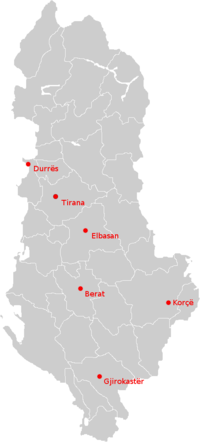
The Holy Synod of Bishops was established in 1997, and is currently composed of:[64]
- Archbishop of Tirana, Durrës and All Albania, head of the Holy Synod: Anastasios of Albania (1992-)
- Metropolis of Berat, Vlorë and Kanina: Ignatios of Berat (1997-)
- Metropolis of Korçë: Joan Pelushi (1999-)
- Metropolis of Gjirokastër, Sarandë and Himarë: Demetrios of Gjirokastër (2004-)
- Metropolis of Elbasan, Shpat and Librazhd: Andon of Kruja (2017-)
- Metropolis of Apollonia and Fier: Nikolla of Apollonia (2014-)
- Metropolis of Amantia Nathanail Stergiou (2017-)
- Titular Diocese of Kruja: vacant
- Titular Diocese of Byllis: Asti of Byllis (2012-)
- General Secretary Protopresbyter: Fr. Jani Trebicka
Gallery
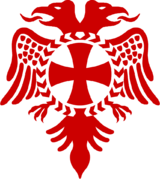 Alternate emblem, used on church flag.[65]
Alternate emblem, used on church flag.[65]
.jpg) Saint Nicholas in Mesopotam, Albania
Saint Nicholas in Mesopotam, Albania_korr2.jpg) Ardenica Monastery in Ardenica, Albania.
Ardenica Monastery in Ardenica, Albania.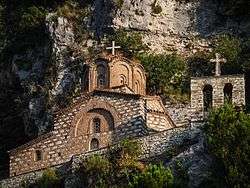 Old Orthodox Church in Berat
Old Orthodox Church in Berat
See also
References
Citations
- ↑ The Christianisation of Albania was apostolic, since Apostle Paul visited the territories of modern Albania. Theofan Noli is the founder of the autocephal church.
- 1 2 "{title}" (PDF). Archived from the original (PDF) on 2011-07-16. Retrieved 2009-12-28.
- ↑ Katić, Mario (2014). Pilgrimage, Politics and Place-Making in Eastern Europe: Crossing the Borders. Ashgate Publishing. p. 140. ISBN 9781472415943.
In spite of the formation of the Albanian Autocephalous (autonomous) Church in 1922 and its recognition by the Patriarchate in 1937, there have been very few subsequent translations of religious literature (see Winnifnth 2002: 135). There is an Albanian translation of the New Testament, used in Greek minority areas and all other areas that managed to hold onto Christianity under Ottoman rule and the threat of Islamization. Except for the officially recognized Greek minority areas and the Himara area, where the liturgy is celebrated only in Greek. Christian communities hold services partly in Albanian and partly in Greek.
- 1 2 John Anthony McGuckin (28 December 2010). The Orthodox Church: An Introduction to Its History, Doctrine, and Spiritual Culture. John Wiley & Sons. p. 72. ISBN 978-1-4443-3731-0. Retrieved 8 June 2012.
The Orthodox currently represent about half a million faithful, worshipping in 909 parishes.
- ↑ CNEWA - Autocephalous Orthodox Church of Albania Archived 2008-01-26 at the Wayback Machine.
- ↑ http://orthodoxalbania.org/alb/index.php/al/
- ↑ http://albanianorthodox.com/
- 1 2 3 4 Ramet 1998, p. 202.
- ↑ Ekonomou Andrew J.. Byzantine Rome and the Greek Popes: Eastern Influences on Rome and the Papacy from Gregory the Great to Zacharias, A.D. 590-752. Roman Studies: Interdisciplinary Approaches. Lexington Books, 2007, ISBN 9780739133866, p. 275
- ↑ Stavrianos 2000, pp. 497–498. "Religious differences also existed before the coming of the Turks. Originally, all Albanians had belonged to the Eastern Orthodox Church, to which they had been attached at the time of the schism between the church of Rome and that of Constantinople. Then the Ghegs in the North adopted Catholicism, apparently in order to better resist the pressure of Orthodox Serbs. Thus the Albanians were divided between the Catholic and Orthodox churches before the time of the Turkish invasion."
- ↑ Kopanski 1997, pp. 193–194.
- 1 2 Lederer 1994, pp. 333–334.
- ↑ Ramet 1998, p. 203. "The Ottoman conquest between the end of the fourteenth century and the mid-fifteenth century introduced a third religion – Islam - but the Turks did not at first use force in its expansion, and it was only in the 1600s that large-scale conversion to Islam began – chiefly, at first, among Albanian Catholics."; p.204. "The Orthodox community enjoyed broad toleration at the hands of the Sublime Porte until the late eighteenth century."; p. 204. "In the late eighteenth century Russian agents began stirring up the Orthodox subjects of the Ottoman empire against the Sublime Porte. In the Russo-Turkish wars of 1768-74 and 1787-91 Orthodox Albanians rose against the Turks. In the course of the second revolt the "New Academy" in Voskopoje was destroyed (1789), and at the end of the second Russo-Turkish war more than a thousand Orthodox fled to Russia on Russian warships. As a result of these revolts, the Porte now applied force to Islamicize the Albanian Orthodox population, adding economic incentives to provide positive stimulus. In 1798 Ali Pasha of Janina led Ottoman forces against Christian believers assembled in their churches to celebrate Easter in the villages of Shen Vasil and Nivica e Bubarit. The bloodbath unleashed against these believers frightened Albanian Christians in other districts and inspired a new wave of mass conversions to Islam."
- ↑ Ergo 2010, p. 26.
- ↑ Ergo 2010, p. 37.
- ↑ Giakoumis 2010, pp. 79–81.
- 1 2 Skendi 1967a, pp. 10–13.
- 1 2 Skendi 1956, pp. 316, 318–320.
- ↑ Giakoumis 2010, pp. 86–87.
- 1 2 Blumi 2011, p. 167. "Negovani’s actions caused institutional responses that ultimately intensified the contradictions facing the church and its imperial patron. In the end, Papa Kristo Negovani was murdered for his acts of defiance of the explicit orders of Karavangjelis, the Metropolitan of Kastoria, who condemned the use of Toskërisht during mass.
- 1 2 3 Ramet 1998, p. 206. "The nationalist cause was given impetus in 1905 when the Albanian priest and poet, Papa Kristo Negovani, was killed by Greek chauvinists after he had introduced the Albanian language into Orthodox liturgy."
- 1 2 3 Gawrych 2006, p. 91. "In one case, a guerilla band executed Father Kristo Negovani (1875-1905) on 12 February 1905, two days after he had performed a church service in Albanian. To avenge his death, a guerilla leader named Bajo Topulli (1868-1930) waylaid and murdered Phiotos, the bishop of Görice, in September 1906."
- 1 2 3 Clayer 2005. para. 7. "Negovani... Au début de l'année 1905, avec son frère lui aussi pope et trois autres villageois, il est victime d'une bande grecque et devient le premier « martyr » de la cause nationale albanaise"; para. 8, 26.
- ↑ Gawrych 2006, pp. 21–22.
- ↑ Poulton 1995, p. 65.
- ↑ Skendi 1967a, p. 174. "The political thinking of the Orthodox Albanians was divided into two categories. Those who lived in Albania were dominated by Greek influence. The majority of them- especially the notables-desired union with Greece. The Orthodox Christians in general had an intense hatred of Ottoman rule. Although this feeling was shared by their co-religionists who lived in the colonies abroad, their political thinking was different."
- 1 2 Nitsiakos 2010, p. 56. "The Orthodox Christian Albanians, who belonged to the rum millet, identified themselves to a large degree with the rest of the Orthodox, while under the roof of the patriarchate and later the influence of Greek education they started to form Greek national consciousness, a process that was interrupted by the Albanian national movement in the 19th century and subsequently by the Albanian state."; p. 153. "The influence of Hellenism on the Albanian Orthodox was such that, when the Albanian national idea developed, in the three last decades of the 19th century, they were greatly confused regarding their national identity."
- ↑ Skoulidas 2013. para. 2, 27.
- 1 2 Clayer 2005b, pp. 217.
- ↑ Kokolakis 2003, p. 56. "Η διαδικασία αυτή του εξελληνισμού των ορθόδοξων περιοχών, λειτουργώντας αντίστροφα προς εκείνη του εξισλαμισμού, επιταχύνει την ταύτιση του αλβανικού στοιχείου με το μουσουλμανισμό, στοιχείο που θ' αποβεί αποφασιστικό στην εξέλιξη των εθνικιστικών συγκρούσεων του τέλους του 19ου αιώνα. [This process of Hellenisation of Orthodox areas, operating in reverse to that of Islamization, accelerated the identification of the Albanian element with Islam, an element that will prove decisive in the evolution of nationalist conflicts during the 19th century]"; p. 84. "Κύριος εχθρός του ελληνισμού από τη δεκαετία του 1880 και ύστερα ήταν η αλβανική ιδέα, που αργά μα σταθερά απομάκρυνε την πιθανότητα μιας σοβαρής ελληνοαλβανικής συνεργασίας και καθιστούσε αναπόφευκτο το μελλοντικό διαμελισμό της Ηπείρου. [The main enemy of Hellenism from the 1880s onward was the Albanian idea, slowly but firmly dismissed the possibility of serious Greek-Albanian cooperation and rendered inevitable the future dismemberment of Epirus.]"
- 1 2 Vickers 2011, pp. 60–61. "The Greeks too sought to curtail the spread of nationalism amongst the southern Orthodox Albanians, not only in Albania but also in the Albanian colonies in America."
- ↑ Skendi 1967a, pp. 175–176, 179.
- ↑ Kokolakis 2003, p. 91. "Περιορίζοντας τις αρχικές του ισλαμιστικές εξάρσεις, το αλβανικό εθνικιστικό κίνημα εξασφάλισε την πολιτική προστασία των δύο ισχυρών δυνάμεων της Αδριατικής, της Ιταλίας και της Αυστρίας, που δήλωναν έτοιμες να κάνουν ό,τι μπορούσαν για να σώσουν τα Βαλκάνια από την απειλή του Πανσλαβισμού και από την αγγλογαλλική κηδεμονία που υποτίθεται ότι θα αντιπροσώπευε η επέκταση της Ελλάδας. Η διάδοση των αλβανικών ιδεών στο χριστιανικό πληθυσμό άρχισε να γίνεται ορατή και να ανησυχεί ιδιαίτερα την Ελλάδα." "[By limiting the Islamic character, the Albanian nationalist movement secured civil protection from two powerful forces in the Adriatic, Italy and Austria, which was ready to do what they could to save the Balkans from the threat of Pan-Slavism and the Anglo French tutelage that is supposed to represent its extension through Greece. The dissemination of ideas in Albanian Christian population started to become visible and very concerning to Greece]."
- ↑ Pipa 1989, p. 196. "Most of the Tosk Orthodox patriots came from Korçë and its regions."
- ↑ Babuna 2004, pp. 294–295. "The Orthodox nationalists were mainly active outside the Ottoman Empire. They made their greatest contribution to the national cause (mainly educational and propaganda work) through the Albanian colonies."
- ↑ Koltsida, Athina (2008). Η Εκπαίδευση στη Βόρειο Ήπειρο κατά την Ύστερη Περίοδο της Οθωμανικής Αυτοκρατορίας [Education in Northern Epirus during the Latter Ottoman Period] (pdf) (in Greek). Aristotle University of Thessaloniki. pp. 306, 313, 331, 391, 401, 403. Retrieved 16 December 2012. (PhD Thesis)
- ↑ Gawrych, George W. (2006). The Crescent and the Eagle. London: I.B. Tauris. pp. 91, 147. ISBN 9781845112875.
"...the assassination of Photios, for his opposition to Albanian cultural activity
- 1 2 Austin 2012, p. 4. "Noli... Hoping to eliminate Greek influence within the Albanian Orthodox Church, he focused his early activities on translating the church liturgy into Albanian and establishing an independent Albanian Orthodox Church. The latter he considered as vital to Albania's evolution into a unified nation and as a major blow to the supporters of the Greek 'Great Idea'."
- ↑ Skoulidas 2013. para. 18, 27-29.
- 1 2 3 4 5 Biernat 2014, pp. 14–15.
- ↑ Skendi 1967a, p. 162.
- ↑ Vickers 2011, p. 61.
- 1 2 3 Austin 2012, p. 4.
- ↑ "The 90th Anniversary Historical Trilogy by Denise Lymperis". Saint George Cathedral.
- ↑ "Orthodox Christians in North America 1794 - 1994". Orthodox Church of America.
- ↑ Tarasar, Constance J. (1975). Orthodox America, 1794-1976: development of the Orthodox Church in America. Bavarian State Library. p. 309. Retrieved 2010-06-14.
- 1 2 Puto & Maurizio 2015, p. 176."However, Greek nationalism continued to be a source of concern for Albanian nationalists later on in the century. After the creation of the Greek state in 1830, and in the light of its mounting expansionist ambitions in the second half of the nineteenth century, the Albanian desire to assert a separate cultural identity represented also a reaction against Greek nationalists, who coveted territories inhabited by Albanians in the Ottoman Balkans, especially in the fiercely contested vilayet of Yiannina, a province containing a mixture of different populations."
- ↑ Malcolm 2002, pp. 77–79.
- ↑ De Rapper 2009, p. 7.
- 1 2 Austin 2012, pp. 31, 95.
- 1 2 Babuna 2004, p. 300.
- ↑ http://shqiptarortodoks.com/tekste/legjislacioni/statuti_1929.pdf
- ↑ http://shqiptarortodoks.com/tekste/legjislacioni/Rregullorja_1929.pdf
- ↑ http://shqiptarortodoks.com/tekste/legjislacioni/statuti_1950.pdf
- ↑ http://80.78.70.231/pls/kuv/f?p=201:Ligj:10057:22.01.2009 Ligj:10057: 22.01.2009
- ↑ Russell King, Nicola Mai (2013). Out Of Albania: From Crisis Migration to Social Inclusion in Italy. Berghahn Books. p. 35. ISBN 9780857453907.
- ↑ Simon, Comeni, Thoma (2013). "Η Θεολογική Διάσταση του Ποιμαντικού Έργου στην Ορθόδοξη Εκκλησία της Αλβανίας (1992-2012) [The Theological Dimension of Pastoral Work in the Orthodox Church of Albania (1992-2012)]". ikee.lib.auth.gr (in French). Artisotle University of Thessaloniki. Retrieved 5 June 2017.
- ↑ Albanien: Geographie - historische Anthropologie - Geschichte - Kultur ... By Peter Jordan, Karl Kaser, Walter Lukan, Stephanie Schwandner-Sievers, Holm Sundhaussen page 302
- ↑ Official site, "The preparation of the new clergy and ecclesiastical education" Archived 2012-07-23 at the Wayback Machine.
- ↑ Romfea news Official site, "Rebuilding" Archived 2012-07-23 at the Wayback Machine.
- 1 2 3 4 Forest, Jim The Resurrection of the Church in Albania, World Council of Churches Publication, August 2002, ISBN 2-8254-1359-3
- ↑ [ Official Site - Publication]
- ↑ Official site "Overview 1991-2012" Archived 2012-07-23 at the Wayback Machine.
- ↑ The Holy Synod of Albania Archived 2008-05-29 at the Wayback Machine., Orthodox Autocephalous Church of Albania, accessed on 2008-06-16
- ↑ (ctrl-click)">Official Site - Photos
Sources
- Anscombe, Frederick (2006). "Albanians and "mountain bandits"". In Anscombe, Frederick. The Ottoman Balkans, 1750–1830. Princeton: Markus Wiener Publishers. pp. 87–113. ISBN 9781558763838. Archived from the original on 2016-01-25.
- Austin, Robert Clegg (2012). Founding a Balkan State: Albania's Experiment with Democracy, 1920-1925. Toronto: University of Toronto Press. ISBN 9781442644359.
- Biernat, Agata (2014). "Albania and Albanian émigrés in the United States before World War II". In Mazurkiewicz, Anna. East Central Europe in Exile Volume 1: Transatlantic Migrations. Cambridge: Cambridge Scholars Publishing. pp. 9–22. ISBN 9781443868914.
- Blumi, Isa (2011). Reinstating the Ottomans, Alternative Balkan Modernities: 1800–1912. New York: Palgrave MacMillan. ISBN 9780230119086.
- Babuna, Aydin (2004). "The Bosnian Muslims and Albanians: Islam and Nationalism". Nationalities Papers. 32 (2): 287–321.
- Clayer, Nathalie (2005). "Le meurtre du prêtre: Acte fondateur de la mobilisation nationaliste albanaise à l'aube de la révolution Jeune Turque [The murder of the priest: Founding act of the Albanian nationalist mobilisation on the eve of the Young Turks revolution]". Balkanologie. IX (1–2).
- Clayer, Nathalie (2005b). "Convergences and Divergences in Nationalism through the Albanian example". In Detrez, Raymond; Plas, Pieter. Developing cultural identity in the Balkans: Convergence vs. Divergence. Brussels: Peter Lang. pp. 213–226. ISBN 9789052012971.
- De Rapper, Gilles (2009). "Pelasgic Encounters in the Greek-Albanian Borderland. Border Dynamics and Reversion to Ancient Past in Southern Albania" (PDF). Anthropological Journal of European Cultures. 18 (1): 50–68.
- Duijzings, Gerlachlus (2000). Religion and the politics of identity in Kosovo. London: Hurst & Company. ISBN 9781850654315.
- Elsie, Robert (2000). "The Christian Saints of Albania". Balkanistica. 13 (36): 35–57.
- Elsie, Robert (2001). A dictionary of Albanian religion, mythology, and folk culture. London: Hurst & Company. ISBN 9781850655701.
- Ergo, Dritan (2010). "Islam in the Albanian lands (XVth-XVIIth Century)". In Schmitt, Oliver Jens. Religion und Kultur im albanischsprachigen Südosteuropa [Religion and culture in Albanian-speaking southeastern Europe]. Frankfurt am Main: Peter Lang. pp. 13–52. ISBN 9783631602959.
- Gawrych, George (2006). The Crescent and the Eagle: Ottoman rule, Islam and the Albanians, 1874–1913. London: IB Tauris. ISBN 9781845112875.
- Giakoumis, Konstantinos (2010). "The Orthodox Church in Albania Under the Ottoman Rule 15th-19th Century". In Schmitt, Oliver Jens. Religion und Kultur im albanischsprachigen Südosteuropa [Religion and culture in Albanian-speaking southeastern Europe] (PDF). Frankfurt am Main: Peter Lang. pp. 69–110. ISBN 9783631602959.
- Hammond, Nicholas Geoffrey Lemprière (1967). Epirus: the Geography, the Ancient Remains, the History and Topography of Epirus and Adjacent Areas. Oxford: Clarendon Press. ISBN 9780198142539.
- Hammond, Nicholas Geoffrey Lemprière (1976). Migrations and invasions in Greece and adjacent areas. Park Ridge: Noyes Press. ISBN 9780815550471.
- Jorgaqi, Nasho (2005). Jeta e Fan S. Nolit: Vëllimi 1. 1882–1924 [The life of Fan S. Noli: Volume 1. 1882–1924]. Tiranë: Ombra GVG. ISBN 9789994384303.
- Kallivretakis, Leonidas (2003). "Νέα Πικέρνη Δήμου Βουπρασίων: το χρονικό ενός οικισμού της Πελοποννήσου τον 19ο αιώνα (και η περιπέτεια ενός πληθυσμού) [Nea Pikerni of Demos Vouprassion: The chronicle of a 19th century Peloponnesian settlement (and the adventures of a population)]". In Panagiotopoulos, Vasilis; Kallivretakis, Leonidas; Dimitropoulos, Dimitris; Kokolakis, Mihalis; Olibitou, Eudokia. Πληθυσμοί και οικισμοί του ελληνικού χώρου: ιστορικά μελετήματα [Populations and settlements of the Greek villages: historical essays] (PDF). Athens: Institute for Neohellenic Research. pp. 221–242. ISSN 1105-0845.
- Kokolakis, Mihalis (2003). Το ύστερο Γιαννιώτικο Πασαλίκι: χώρος, διοίκηση και πληθυσμός στην τουρκοκρατούμενη Ηπειρο (1820–1913) [The late Pashalik of Ioannina: Space, administration and population in Ottoman ruled Epirus (1820–1913)]. Athens: EIE-ΚΝΕ. ISBN 960-7916-11-5.
- Kopanski, Atuallah Bogdan (1997). "Islamization of Albanians in the Middle Ages: The primary sources and the predicament of the modern historiography". Islamic studies. 36 (2/3): 191–208. JSTOR 23076194.
- Koti, Dhori (2010). Monografi për Vithkuqin dhe Naum Veqilharxhin [A monograph of Vithkuq and Naum Veqilharxhi]. Pogradec: DIJA Poradeci. ISBN 978-99956-826-8-2.
- Koukoudis, Asterios (2003). The Vlachs: Metropolis and Diaspora. Thessaloniki: Zitros Publications. ISBN 9789607760869.
- Lederer, Gyorgy (1994). "Islam in Albania". Central Asian Survey. 13 (3): 331–359. doi:10.1080/02634939408400866.
- Limanoski, Nijazi (1989). Islamskata religija i islamiziranite Makedonci [Islamic religion and Islamisied Macedonians]. Skopje: Makedonska Kniga.
- Mackridge, Peter (2009). Language and national identity in Greece, 1766–1976. Oxford: Oxford University Press. ISBN 9780199599059.
- Malcolm, Noel (2002). "Myths of Albanian national identity: Some key elements". In Schwanders-Sievers, Stephanie; Fischer, Bernd J. Albanian Identities: Myth and History. Bloomington: Indiana University Press. pp. 70–87. ISBN 9780253341891.
- Nitsiakos, Vassilis (2010). On the border: Transborder mobility, ethnic groups and boundaries along the Albanian-Greek frontier. Berlin: LIT Verlag. ISBN 9783643107930.
- Norris, Harry Thirlwall (1993). Islam in the Balkans: religion and society between Europe and the Arab world. Columbia: University of South Carolina Press. ISBN 9780872499775.
- Pipa, Arshi (1989). The politics of language in socialist Albania. Boulder: East European Monographs. ISBN 9780880331685.
- Pistrick, Eckehard (2013). "Interreligious Cultural Practice as Lived Reality: The Case of Muslim and Orthodox Shepherds in Middle Albania". Anthropological Journal of European Cultures. 22 (2): 72–90.
- Poulton, Hugh (1995). Who are the Macedonians?. Bloomington: Indiana University Press. ISBN 9781850652380.
- Puto, Artan; Maurizio, Isabella (2015). "From Southern Italy to Istanbul: Trajectories of Albanian Nationalism in the Writings of Girolamo de Rada and Shemseddin Sami Frashëri, ca. 1848–1903". In Maurizio, Isabella; Zanou, Konstantina. Mediterranean Diasporas: Politics and Ideas in the Long 19th Century. London: Bloomsbury Publishing. ISBN 9781472576668.
- Skendi, Stavro (1956). "Religion in Albania during the Ottoman rule". Südost Forschungen. 15: 311–327.
- Ramet, Sabrina (1998). Nihil obstat: religion, politics, and social change in East-Central Europe and Russia. Durham: Duke University Press.
- Skendi, Stavro (1967a). The Albanian national awakening. Princeton: Princeton University Press. ISBN 9781400847761.
- Skoulidas, Elias (2013). "The Albanian Greek-Orthodox Intellectuals: Aspects of their Discourse between Albanian and Greek National Narratives (late 19th - early 20th centuries)". Hronos. 7.
- Stavrianos, Leften Stavros (2000). The Balkans Since 1453. C. Hurst & Co. Publishers. ISBN 9781850655510.
- Vickers, Miranda (2011). The Albanians: a modern history. London: IB Tauris. ISBN 9780857736550.
- Winnifrith, Tom (2002). Badlands-borderlands: a history of Northern Epirus/Southern Albania. London: Duckworth. ISBN 9780715632017.
External links
| Wikimedia Commons has media related to Albanian Orthodox Church. |
- Official website
- Article on the Orthodox Church of Albania by Ronald Roberson on CNEWA website
- History of the Establishment of the Church at the Wayback Machine (archived 2005-10-17)
- History and description of the Orthodox Church of Albania on World Council of Churches website at the Wayback Machine (archived 2008-07-09)
- Orthodox Peace Fellowship report on Albania at the Library of Congress Web Archives (archived 2006-07-11)
